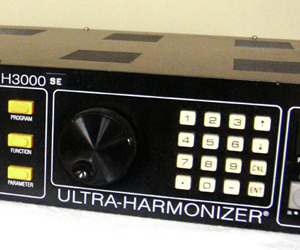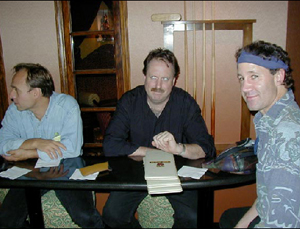Classic NY Gear: The Eventide H3000 UltraHarmonizer
Just over a month ago, we took a snapshot of Eventide at age 40. This story followed the paths of founder Richard Factor and Director Tony Agnello from the company’s infancy through to the present day, focusing on their earliest designs, as well as their latest releases.
What we didn’t have room for was a thorough look at all the intervening years, some of which were marked by significant growth, and some of which were markedly less fruitful. Instead, we heard more about those many middle years from you, our readers. The story of Eventide turned out to be a popular one, and it brought in a lot of mail. Unsurprisingly, there was one name kept turning up again and again in your letters: The Eventide H3000.
Ubiquitous
There was a good stretch of time in the last quarter of the 20th century when there might have been nearly as many H3000 UltraHarmonizers in the field as there were professional audio engineers. In its many incarnations, this unit was a runaway smash, rivaled in the world of professional multi-effects only by the Yamaha SPX-90.
While the SPX-90 had the market cornered on affordable reverbs, the H3000 arguably had Yamaha beat when it came to creating startling pitch-based effects and powerful filters. In 1987, Eventide’s new milestone box featured the first intelligent diatonic pitch shifting available, and came packaged with hypnotizing presets that made it a hit on showroom floors.
If the sound of the SPX-90 was practical, predictable, and impressive for the price, then Eventide’s newest toy was marked by its distinct personality. It had a voice of its own, in large part, because it was a personal project.
A Small Team, Left Alone
“They were the new guys,” says Wave Distribution‘s Gil Griffith about the designers of the H3000. “They had written a lot of good code, but hadn’t had their own product yet. So these were guys who had something to prove. They’d sweat bullets to get the job done and make something great.”
Griffith had seen the design team at Eventide work on the H3000 first-hand while he was on staff there, heading up sales and marketing. He’d also go on to represent some of the key players of that team as they started up their own companies years later.
At that time, a young Ken Bogdanowicz and Bob Belcher were the core of the digital design team charged with creating the new rackmount platform and figuring out what new tricks they could make its DSP do. (The two would later go on to work with each other again, developing a suite of popular plug-ins for Bogdanowicz’ company, SoundToys.)
“If I remember correctly, Bob was doing essentially two full-time jobs at once,” says Griffith, “designing both the hardware and the operating system on which the programs would run. He could have been working 100 hours a week or more. It really seemed super-human at the time.”
Bogdanowicz of SoundToys says he remembers walking into the office on some early mornings to find his partner, Belcher asleep at his desk, having worked through the night before.
“And they were all musicians, not just engineers, so I think it’s no surprise the design resonated with musicians who bought them too,” says Griffith. In on of their prouder moments, Brian Eno even wrote the team “out of the cold” to rave about the box.
According to Belcher and Bogdanowicz, they solicited the feedback of working engineers, including Bob Clearmountain, and did a lot of testing outside the shop, often at the studio of a third key colleague, David Derr.
Derr was a young newcomer who spent his time with the team testing components and trying to figure out how to make the analog path in the H3000 perform at its best. He’d go on to found Empirical Labs and design one of the best-selling boutique compressors of our era: The Distressor. Still, he’s humble about his work, and his start with Eventide.
“I’m not a real ‘engineer.’ I think I was hired at Eventide based on a fluke test that I happened to do well on in the interview. To be honest, I learned everything I know there from Bob and Ken. There wouldn’t be an Empirical Labs today if it wasn’t for them.”
“But I also have to give a lot of credit to [founder] Richard Factor. He gave me the time to learn on the job, there was a lot I was figuring out as I went along, and he also allowed the space to test and to try things. The goal was increasing performance, not just getting the job done.”
Griffith agrees this is what he saw: “I think that’s how you design a great product. You get these really talented people together who are working for more than just a paycheck, and you kind of leave them alone.”
The result is a modular-style digital multi-effect that lives on in studios racks almost 25 years later, and now, even inside laptops. There’s a good chance we’ll see the heritage of this box live on for another 25. Somehow, through decades of new product releases, the H3000 survives. The sounds are classic and futuristic at once; identifiable, but still capable of new surprises. It would be hard to say the same for much of the digital technology of its era.
Justin Colletti is a Brooklyn-based producer/engineer and a journalist who writes about music and how we make it. Visit him at http://www.justincolletti.com.
Please note: When you buy products through links on this page, we may earn an affiliate commission.









